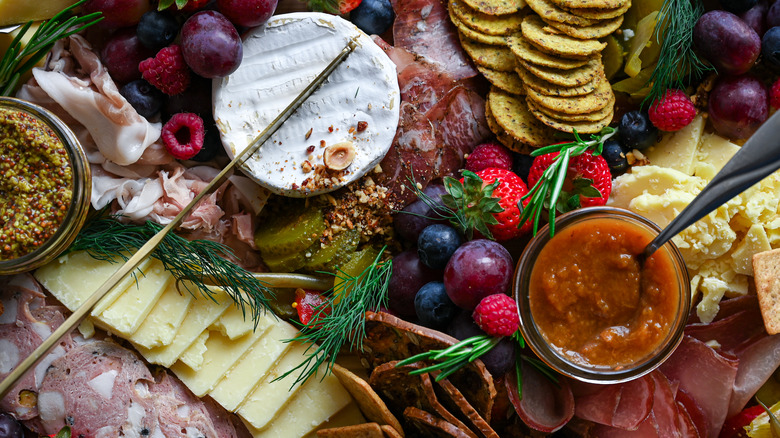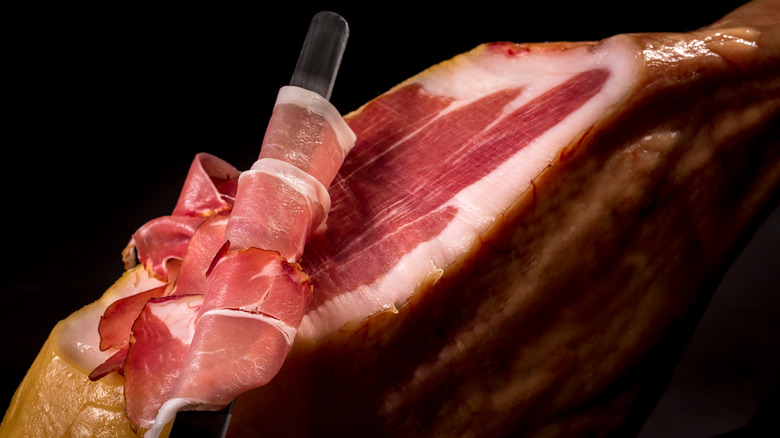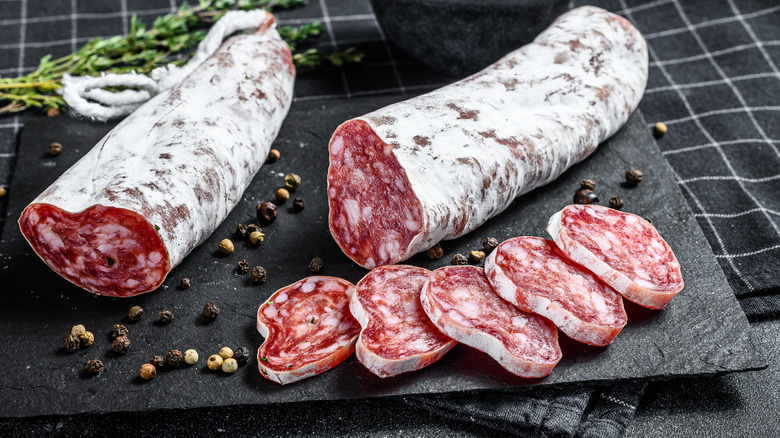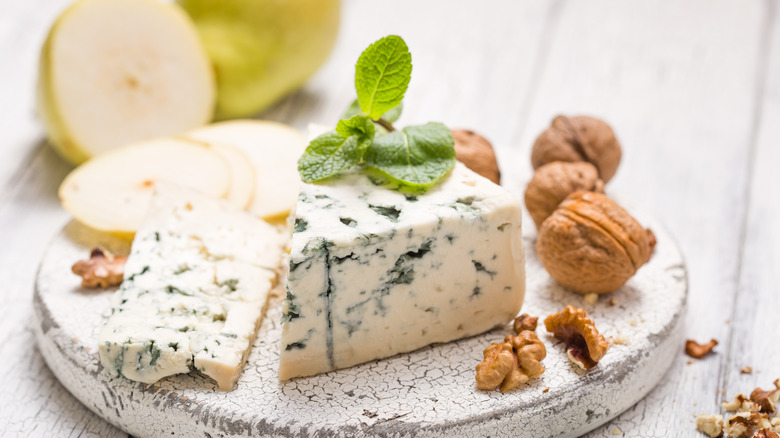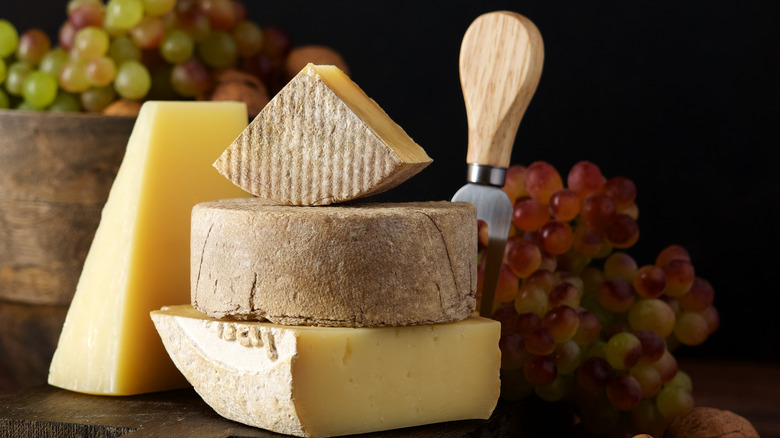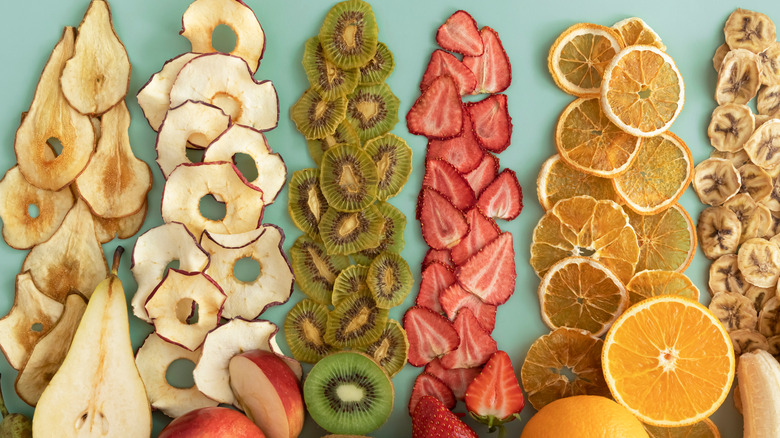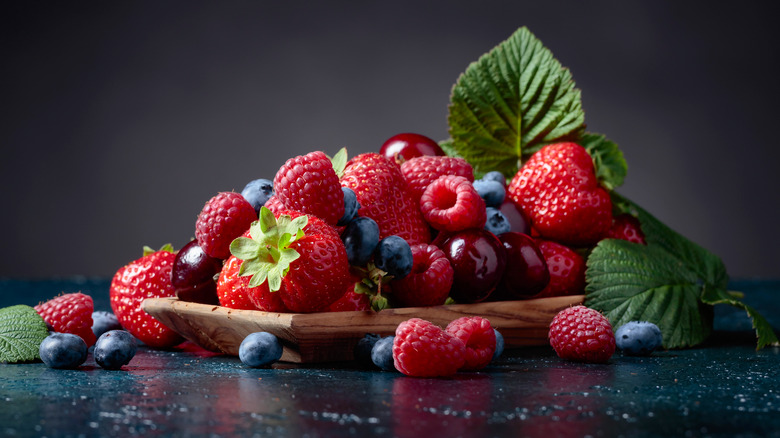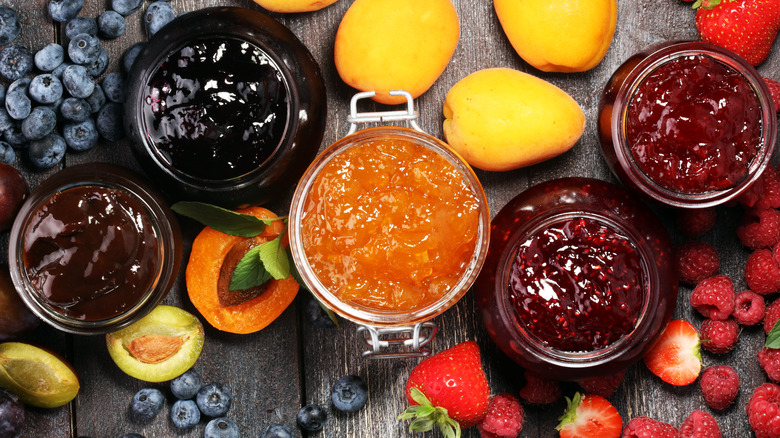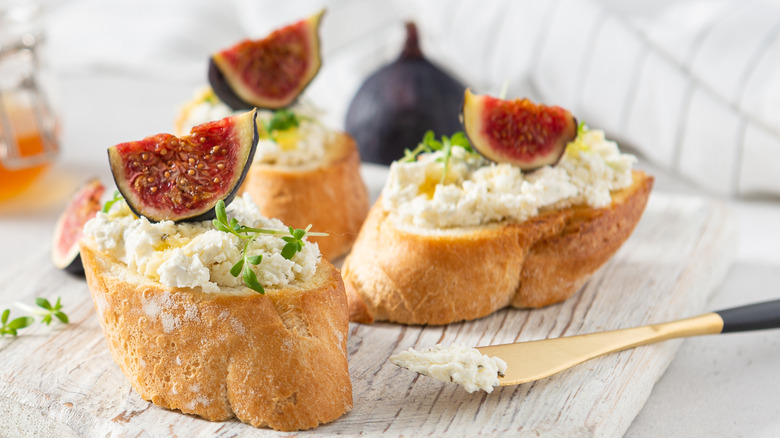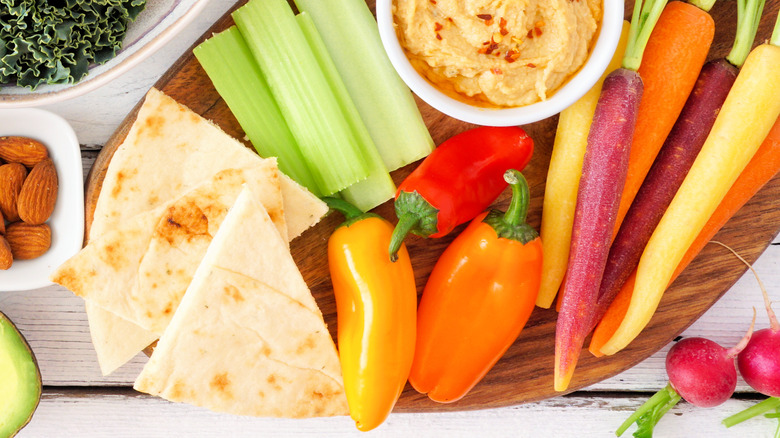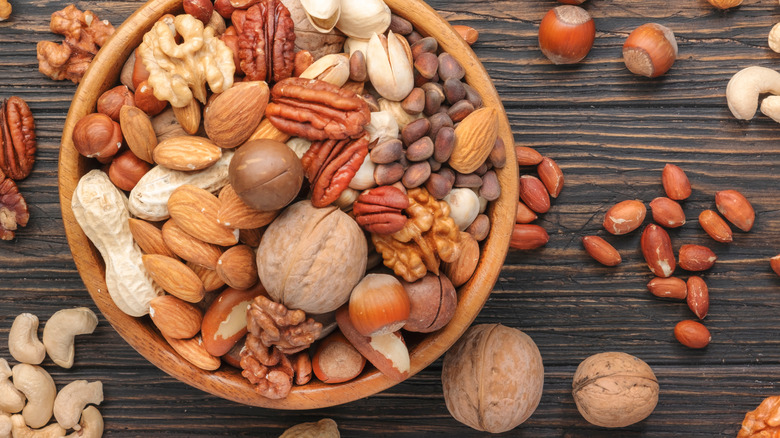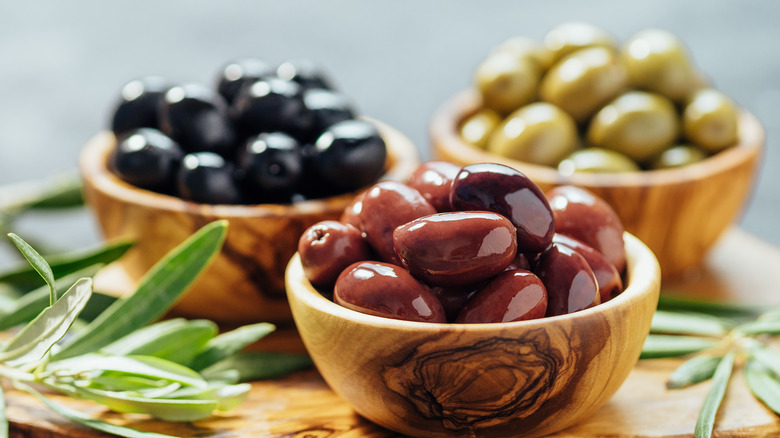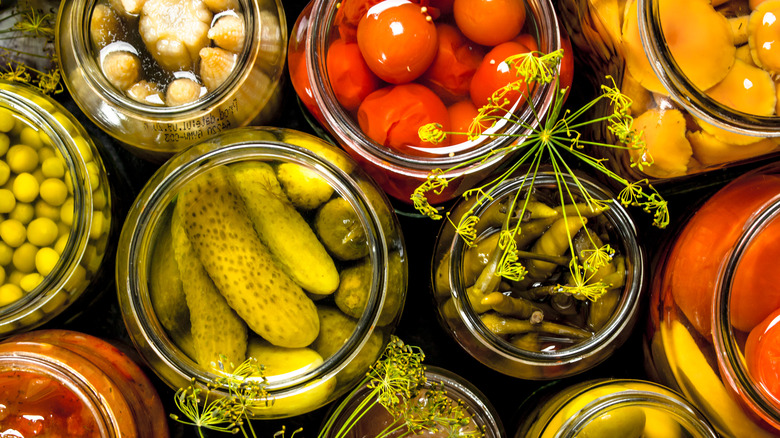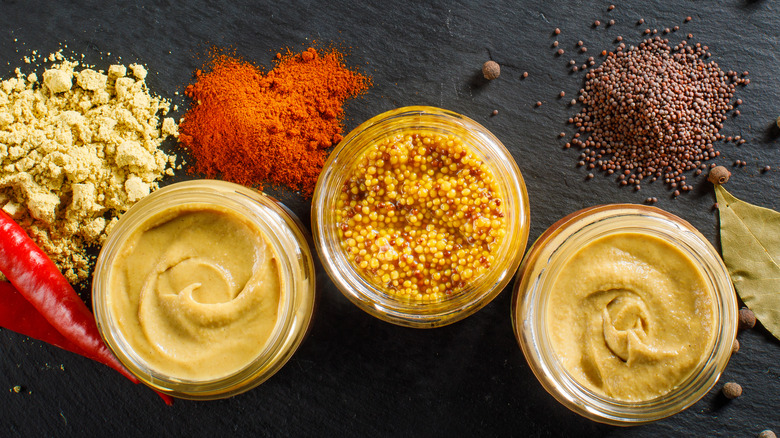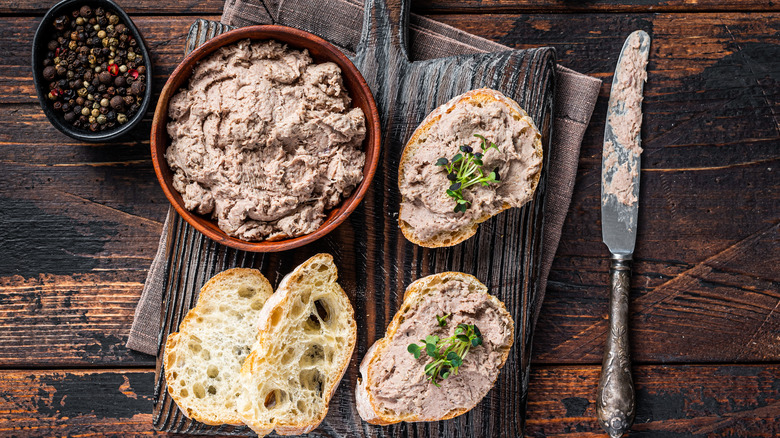14 Must-Have Items For Your Thanksgiving Charcuterie Board
The Thanksgiving game has changed. What used to be a feasting holiday with a heavy focus on big basted birds and boatloads of carbs is now ... Actually, the game hasn't changed that much. Folks still come for the turkey, re-up on the sides, and stay for the home-baked pies. Yet these days, with Friendsgivings, and the distance that Americans are traveling to spend the holiday with each other, appetizers are playing a big part in feeding hungry guests, which is why we recommend breaking out the ever popular charcuterie board for Thanksgiving.
Choosing your charcuterie lineup of small bites of cheeses, cured meats, and beyond is all about going off the rails in search of new taste combinations. Take some liberty with the way you dress up your board, use it as an excuse to empty the pantry, and get creative with melding different flavors or textures. But keep in mind that in this day and age there are few rules: Ask about allergies and remember that finger foods still need serving utensils.
These suggestions are provided to give you a holistic rundown on all the things you could add to your Thanksgiving charcuterie board. You'll find plenty of foods to feed the gluten-free, the vegan, the no-nuts, and even the plain old picky. And if you need tips on choosing the traditional cheese and meat items, they are in here too.
Dry-Cured Hams
Thanksgiving main courses may be all about the turkey, but the parties that also offer holiday ham are the ones with a truly full bounty. In the same way, your Thanksgiving charcuterie board should be filled out with a good bit of dry-cured pork. Ham cuts sliced paper thin are common in just about every traditional form of charcuterie plate, and they are great finger-food-sized bites for your guests.
There are several different varieties of dry-cured ham for you to stock a charcuterie board with. The most common is the Italian meat Prosciutto di Parma, a specially chosen ham leg cured in Italy under specific conditions and offering a soft, velvety mouthful of salty protein. If you want to pile on other Italian cured hams, consider adding capicola to your boards. This one brings a cold smokiness to your appetizer plates, as well as a bit more sustenance as it is often cut thicker than prosciutto.
Different from both of these Italian options is the Spanish Jamón Ibérico, a fattier, deep-red ham offering a full burst of flavor. The pricey ham is cut with a rougher hew and served warmer than Italian cold cuts in order to reach a true melt-in-your-mouth temperature. Like Parma hams, only certain pigs and producers achieve the grassy, herb-accented Jamón Ibérico status, making it a must have for your Thanksgiving feast.
Dried Sausages
Striking a balance between soft, firm, and hard cheese is fundamental when building an appetizer plate, and so is taking the same consideration with your cured meats. The world of charcuterie goes far beyond the thin meats that melt to fat in your mouth. Your Thanksgiving guests need something to sink their teeth into and dried sausages are where they turn.
Even among dry sausages there can be a big difference in density. Despite having similar red wine and garlic flavors, hard salami has a lower fat count than Genoa salami making it drier and tougher to bite through (via Bon Appétit). After taking consistency into account, think about the flavor you are going for. Regional seasoning will impact taste, but knowing how the sausage is made also shows a difference: Genoa and hard salami may be flavored the same, but the latter is smoked and will taste like it.
Herbs are a heavily used ingredient in dry sausage making, and certain varieties actually get their identity from them. For example, soppressata is a black-peppered Italian sausage that has a thick rind and slightly spicy flavor, while finocchiona is a salami specifically characterized by the addition of dried fennel (via La Cucina Italiana). Dried sausages are made from either pork, beef, or a combination of both. Different styles of preserved meats will come in different slice thicknesses, and some have natural cases which may deliver rough, rustic edges when cut.
Soft Cheese
Charles de Gaulle said of France, "How can you govern a country with 246 varieties of cheese?" To reframe that around American Thanksgiving we should be asking: "How can we fit 246 types of cheese onto our charcuterie boards?" Is that a lot of cheese? Sure. Is it too much cheese? We're offended that you'd even ask.
We stand by the charcuterie cheese board rule of providing options with different textures. A board stocked with only firm or hard cheeses will miss out on all the spreadable textured goodness that's out there. It also leaves out on a world of unique flavor combinations.
Along with offering health benefits, goat milk cheeses like chèvre come in a mix of tastes from herb and garlic, or lavender and fennel. The variety allows it to be a plain topping for crackers or a unique match to other foods. If you are looking for a deep and funky flavor then consider crumbled Gorgonzola, a bleu cheese loaded with odor and punch. Camembert and brie are a few other soft cow milk cheeses that provide the perfect pairing to sweet toppings such as honey or jam, while also giving off a more mild stink than anything bleu.
Also look for individually-sized cheeses like pearled mozzarella or marinated feta — think about the tiny grab-and-go bites that might come in handy for a hungry host.
Firm and Hard Cheese
After you've settled on your soft cheeses, the next item for your Thanksgiving charcuterie board should be to cheeses of firm to hard textures. The types of choices you have are endless and selecting the right one for your board can be overwhelming, although it doesn't have to be.
Your hardest cheeses are going to be styles like chunked parmesan, asiago, and aged gouda. These cheeses won't have many of the novel flavors that softer varieties do, but the time it takes to ripen them leaves a different type of character. Parmigiano Reggiano is a dry, salty cheese that has a storied history. If you are looking for something flavor-infused, consider an aged gouda which can have accent flavors added, or even a smoked profile.
Gruyère is another popular item to have among your firm cheese selections. The smooth, pale yellow food adds a Swiss touch to any Thanksgiving charcuterie board. It slices easily, takes awhile to sweat, and will remain a fresh snack all throughout the day. Other popular firm cheeses include sharp and aged cheddar (a good choice if you are looking for a pre-sliced option). Some cheddars even come embedded with mustard seeds for an extra pungent morsel.
Dried Fruits
Where there's smoke, there's fire; and where there are salty treats, there are sweets. If that isn't a saying you previously lived by, then perhaps building Thanksgiving charcuterie board is the time to take it up. Interspersing fruit between the piles of cured meats and cheeses stacked high on your charcuterie plate will give guests a variety of complimentary tastes. More specifically, dried and preserved fruits can add a deeper layer of sweet accent to the saltier items.
Dried blueberries are an easy-to-find item to start with. Since they won't perspire like fresh blueberries, dried ones can stay out on your food station longer without making a mess or losing freshness. Additionally, dried tart cherries can be a sweet and tangy addition to your boards though they are on the higher end as far as cost goes. A good in-between? Dried apricots. Keep an eye out for the Blenheim variety, a California apricot that is more slab-like in shape and less-sweet in flavor. It is the kind of dried fruit that can be sandwiched between other items on a cracker, or take on the role of serving vessel for your next bite of crumbled cheese.
Speaking of dried fruit that can also serve as a base, citrus wheels have the texture to hold up under cheese and meat while providing a complex finish.
Fresh Fruit
Dried fruit may add something different and new to your charcuterie, but raw fruit provides something fresh. Pairing the right fruit to your Thanksgiving charcuterie will create some spaces on the board where guests can turn for a revitalizing bite for something that refreshes and cools their taste buds after a salty snack. Professional charcuterie builders Bountiful Grazing recommend serving fresh fruit in a way that is different for each type of produce, but there are a few rules that are common no matter the produce.
First, try and choose fresh fruit that has edible skin. (Grapes, strawberries, and fresh cherries are a good example.) The skin serves two purposes: On the culinary side, it keeps a berry's flavor hidden behind a wall until that perfect moment when an eater noshes into their bite. Additionally, fruits with a firm skin will help to improve your presentation since they won't leak juice across the expanse of your charcuterie board or kitchen table. For that reason, melons aren't a great option unless they are served in some sort of bowl.
Keep the size of fruit in mind when choosing fresh options for your charcuterie pairings. Pre-cut pear slices are perfect to scoop with, and a halved (or quartered) fig is the perfect size to top off a goat cheese crostini. Consider leaving your grapes on the vine for a rustic presentation and add several different colors to increase the variety of flavors across your appetizer feast.
Sweet Sauces
Your charcuterie board can be piled high with hearty ingredients but unless you've got the right spread to top it all with, you'll be missing a chance to round out the flavor wheel. Because of the generally salty profiles of meat and cheese-heavy boards, sweet condiments are a compliment. Some common options are jams, marmalades, compotes, and chutneys.
Store-bought jams and preserves are the least-hassle free way to go, though they'll add the most possible sugar to your bite. However, if you're feeling industrious there are some easy homemade recipes out there for homemade jam. If you are wanting to add a sweet and savory something-something, consider going with a chutney. These can be purchased in deep flavors like onion or tomato, and also have not-so-sweet fruit styles like spiced cranberry. The mashed consistency of chutney has a pithy and new texture for your guest's palates.
Don't forget that having warm brie without a drizzle of honey is a crime against the season. Fattier, creamy cheeses like these don't seem too heavy when touched with a little sweetness. Jams can also cut the sharp flavors of bleu cheese or add a bit of tanginess to something plain. With charcuterie, mix-and-match is the name of the game, and including plenty of sweets is a home-field advantage.
Something Bready
One of the most important parts of any charcuterie board (and life) is the carbs. Unfortunately, bread and crackers are most often the afterthought. Triscuits and Wheat Thins will always do in a pinch, but if you're looking to build a board that blows your guests away, consider going the specialty route for your appetizer platter.
Charcuterie board makers Siroh and Ivy recommend starting with something neutral to pair with your cured meats and cheeses. A cheesy or herbed bread like focaccia will overwhelm the subtle flavors of your sausages or hams. Instead, consider a sliced French baguette which gives a neutral, rustic flavor and presentation. If you need something easier to bite then go for crackers. Ritz and Saltines will make your nibbles too salty so opt for something with less sodium. Rice crackers and water crackers make another mild base while nut-based crackers can give your gluten-free friends something to graze on.
Another easy and flavorful option? Baking your own crostini. These are simple and traditional charcuterie bases which can be made by toasting oiled slices of French bread. Look for a golden color coming out of the oven, and consider baking them with a light dusting of dried rosemary. This can be a time consuming process though, so if you've already got too many pans in the oven then stick with the store-bought options. Also consider giving whole wheat breadsticks or seed crackers a try (via Striped Spatula).
Vegetables
One sly way to bulk up your board is to add vegetables. Both marinated and fresh produce can serve different purposes: Vegan friends and family will be grateful for options that extend to fit their diets while flavor seekers will be impressed with the presence that vegetables bring to a board. Adding vegetables is thrifty, resourceful, and (considering the rest of what a turkey day meal involves) totally qualified as self-care.
There are a few ways to add veggie goods to your charcuterie display. After shaking some of the moisture off in a colander, fill your appetizer board with canned vegetables such as artichokes or beans. When paired with the right cheese, marinated mushrooms are another preserved food that adds meatiness for your diners.
In addition to pre-prepared vegetables, fresh cuts will always be a natural choice. Bell peppers, carrots, and celery are all garden veggies which can be given a julienne cut before fitting nearly anywhere on the board. That particular slice will turn them into little organic dippers for your mustard, jams, or honey. A sliver of fresh carrot wrapped with prosciutto might make you wonder why turkey is still getting all the attention.
Nuts
It would be nutty to make a Thanksgiving charcuterie board without adding this important food group. Nuts are an important ingredient around holiday time but they are also a thrifty way to fill up blank space when serving charcuterie. Whether you've foraged a mixed combination from the back of the pantry, or searched out a particular variety in the grocery aisles, scattering stashes of nuts across your board gives a seasonal look and flavor.
It's not unusual to find nut-studded cheeses around the holidays, but getting imaginative with your own pairings can be a creative way to increase the offerings on your board. Diamond Nuts has a host of recommendations for matching nut varieties to cheese styles, with the biggest tip being to consider textures. Sharp cheddar may be a firm cheese already, but pairing it with a denser nut (like almonds) will accentuate the best parts of it. Similarly, a creamy bleu cheese can be given just the right amount of crunch when stacked high with cashews. The consistency of nuts can be your North Star, but don't neglect flavor: Pistachios are a nut that is often served salty, so mixing them with your hard Parmesan will highlight the strongest aspect of both foods.
Along with being served raw, seasoned nuts are also an inventive play for your cheese plates. A little seasoning can go a long way, and a recipe like spiced roasted almonds illw give your board some heat. For a sweet treat, add cinnamon-roasted Bavarian almonds. There is a bounty of options to fit the season.
Olives
When you're building a Thanksgiving charcuterie board you will want to hit the alternative flavors of sweet and tangy, but you can't forget the all-important salty snack.For a non-meat accoutrement that lends a salty balance to the creamy soft cheeses and sweet condiments of your spread, you can't go wrong with olives. They're great finger food, come in multiple variations (including stuffed), and are easily available. You won't want to miss adding a bowl of them for folks to mix and match with dried sausage and aged dairy. You can eat them fresh, but traditional charcuterie olives are most always cured. Some varieties are soaked in seasoned, herb-filled brines, essentially making them a form of vegetable charcuterie. Score another one for the vegans.
Olives offer a lot of variety. Green Castelvetrano olives are large and buttery with a mild taste — great for grazers of all stripes. If you want a type that puts out more of the brine note, black Kalamatas, green French Picholines, or Italian Laguria olives are where to focus. If you are going for a board themed by particular flavors, seasoned and marinated olives can match your curated vibes.
Pickles
Another briny staple of charcuterie boards are pickles. The beautiful thing about pickles: anything can be one — onions, cucumbers, radishes, even watermelon rinds. The science of soaking a neat ingredient in a well-mixed brine is one of the earliest forms of food preservation. They may have a hip reputation these days, but snacking on pickles is a connection to age-old human eating habits, just like air-dried meats or fruit and vegetable foraging.
If you can eat it fresh, then chances are it could be a pickle on your next charcuterie plate. There are the traditional pickled cucumbers: made from different cucumber varieties, served whole or sliced, brined in more flavors and tastes than there are people in the world. One especially popular style is the gherkin, which is small enough to be eaten in a single bite even when served whole.
Along with previous tips for preserved fruit, choose a few pickled veggies to take your Thanksgiving charcuterie beyond the classic cucumber. Pickled onions are an easy place to start. White onions will take on a pink color when brined, often becoming a bright spot of pizzazz for your board, with a zippy flavor to match. Pickled peppadew peppers add a spicy touch that will warm diners behind their cheeks. Added to a cheese ball, they are just the thing for a smoldering mouthful. Other top pickles to serve? Okra is a popular Southern style, and Italians have a spicy relish of pickled carrots and cauliflower called giardiniera which adds a brightening pop.
Mustards
Mustard is a must-have companion for your plate. As the Cheese Professor notes, a cardinal rule of charcuterie pairing is to combine the flavors of similar regions — this cheese with this fruit, this meat with that wine. Since recipes and styles of peppery mustard dressing have been found independently originating all over the world, mustard is a match for any and all of the worldly cheeses, sausages, and hams that you can find.
Mustard has a lot of different personalities. From Dijon to honey, there are numerous ways to consume the pungent spread. So, how do you include it onto your Thanksgiving charcuterie board in a way that is easy for a crowd to share and doesn't overwhelm the flavors of a carefully curated plate? With a few simple rules: For starters, consider the texture of the mustard you want to serve. Whole grain style will give your bites a round, roe-like mouthfeel and a musty flavor, while spicy brown is a creamy topping that packs a punch. There are horseradish mustards for those who like a spicy bite with a mealy texture. Don't forget about the sweetened mustards that'll take your tongue on a ride.
In addition to sweet, spicy, or hot mustards, there are lots of brands out there selling flavor-infused varieties. Mustards that have the added essence of dill, smoked onion, or even nuts (like pecans) can be a fun way to play around with the sauces on your board. The vinegar zest of mustard is not something to forget.
Soft Meat Spreads
Soft charcuterie is a unique way to present the flavors of prepared meat on your Thanksgiving board without having to serve whole cut hams like prosciutto or dry sausages. The mix of soft options, from pâtés to terrines to rillettes, offer complex flavors in a smooth format. Not everyone is down with eating spreadable meat, but those who are will definitely appreciate the availability of it.
On a scale from smoothest to most textured, a pâté (which is a finely ground meat) will have the most silken consistency and rillettes (finely shredded meats) have a relatively smooth feel while being more textured than pâté. Both meat spreads are often made from pork, beef, duck, rabbit or even salmon. Terrines, a combination of anything from packed meats, egg, vegetables, and pastry, will offer the most substantial bite.
Pâté and rillette are most often served spread onto a baguette or crackers. As for terrines, the density is filled with so many ingredients that they are often an entire charcuterie board in one bite. Move over turkey — there is a new main course this Thanksgiving.
